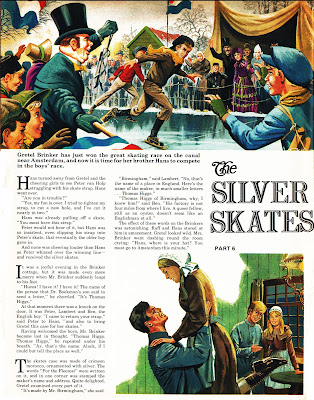Saturday Leftover Day.
Among my many jobs I do the 'news' pages for the Dutch bi-weekly comic magazine Eppo. In the first issue this year I covered an interesting new find. Dutch comic artist Bert Bus (most famous for continuing the British strip Robot Archie for the Dutch Sjors magazine in the early seventies) illustrated the five part story of Hans Brinker for the British kid's weekly World of Wonder. A few of the originals turned up in the original comic art collection of the Allard Pierson Museum of the Amsterdam University. Curator Jos Waterschoot asked Bas Schuddeboom (curator of the Lambiek Comiclopedia and one of Holland's most noted comic researchers) to explain what the WoW could stand for. This led him to World of Wonder, where I proceeded to find all the episodes shown here. Talking about it, we also came up with a theory how this remarkable piece could have been produced. In the recent biography of John Sanders (long time head of IPC and co-creator of 2000 AD) he found some pages about the collaboration between the British IPC and the Dutch VNU publishing corporations between 1970 and 1975. Together they set up and exchanged several new magazines: the girls comic Tina (which was also sold to France, Germany and a couple more countries), the kids fairytale magazine Disneyland (published both in the UK and in the Netherlands), the toddlers mag Bobo (UK and Netherlands) and a educational science and history magazine for kids, called World of Wonder in the UK and Kijk in the Netherlands. Sanders mentions being asked by the VNU to have all the printing being done by their presses and how that might give problems by the unions. Apparently the union problems were solved, because the indica of World of Wonder give the VNU as the printer.
So this is how we think The Silver Skates came to be. The story of the Dutch boy on silver skates that helped stem the flooding of the dikes is not a Dutch story. It was written in the UK and though heard of in the Netherlands, not a staple of our kid's entertainment. So we think the idea to do an adaptation of the story must have originated with the World of Wonder editors - who, by the way, did all of the contents, which was translated without additions for Kijk. But since there were already contacts between IPC and VNU, why not pick a Dutch illustrator? Bert Bus may have already been know to them through his work on Archie and maybe even the two original comic strips he did for the Dutch Tina, Nancy Drew (1969), illustrated text story written by Carolyn Keene) and Jola and the Space Race (1970, sciencefiction comic strip written by Bus himself). Bert Bus worked on salary for one of the VNU partners, Spaarnestad, so he could he put to work at no extra cost.
Some questions remain, though. We have not yet found this story in the Dutch World of Wonder, Kijk. There is no seperate index of this magazine and we are looking for actual copies. The printing of the magazines was simultaneous, so we know whe have to look at the last few months of 1971.
Bert Bus' two stories for Tina may have been produced in the same way. When Nancy Drew ran, Tina was still completely translated from the English version (which by then may have been pulled into the similar magazine Princess, as was Sander's habit - he often published similar magazines and pulled them together under the title of the most succesful one). Issues of Princess Tina from that period are hard to find, though, actual or digitally. Was Bert Bus the first artist to work directly for Tina or was he translated, just like the rest? And did Bert Bus do more work for IPC through this connection - possibly even for World of Wonder?












No comments:
Post a Comment